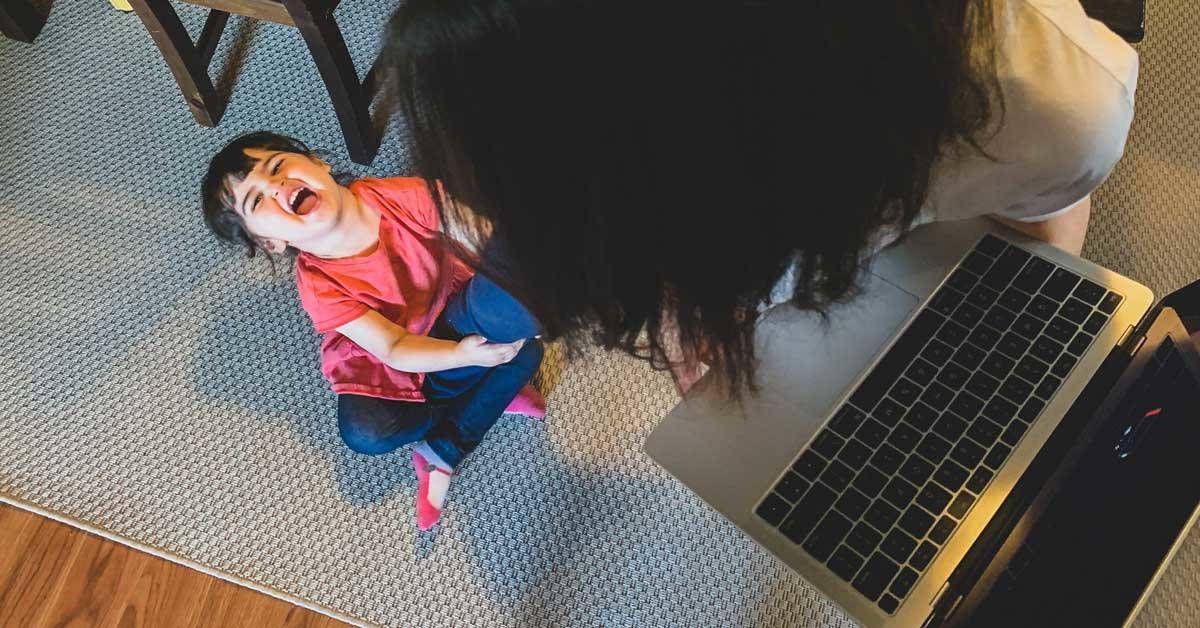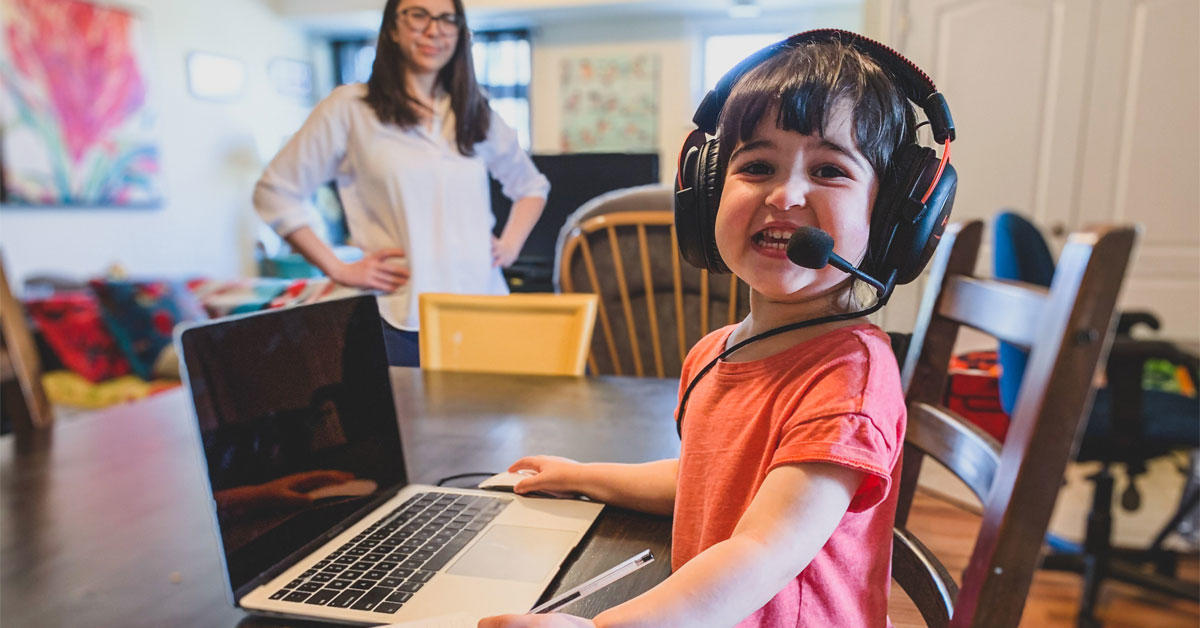
By Sabrina Daniel
The author works as a content creator at uOttawa's Communications Directorate.
When my two-and-a-half-year-old daughter feels anxious or upset, she sucks her thumb and clutches her “doudou,” a fuzzy receiving blanket that she cannot live without. Since the start of the pandemic, and my stint as a stay-at-home working mom, I’ve noticed that she sucks her thumb a lot more—to the point where her skin is getting raw.
Like so many parents adapting to confinement, I feel underslept, overworked and I have very little time to decompress and recharge. This, in turn, makes me quicker to anger or frustration and less attentive to my daughter’s needs. I’m wracked with feelings of guilt and inadequacy, and I worry that I’m not cutting it as a parent.
This situation poses even greater challenges for single parents, parents living with mental health issues or disability, parents who are frontline workers or struggling to make ends meet.
So, what’s a parent to do? As a University of Ottawa employee, I am fortunate to have access to a wealth of academic knowledge and expertise. I shared my fears with some of uOttawa’s experts in psychology and early childhood development and asked them for guidance. Here’s what they had to say.

I’m worried that I’m not properly tending to my child’s emotional needs and that it will impact her sense of security.
To tackle this fear, uOttawa alumna Lauren Scarsella, a psychotherapist in private practice who specializes in developmental trauma, introduced me to the concept of ‘good enough parenting,’ a term coined in the 1950s by British Psychoanalyst D.W. Winnicott to address the pressure to parent perfectly.
Winnicott’s most important takeaway is that it is unrealistic to expect parents to be perfectly attuned to their children’s emotional needs, and that a successful parent is one that is ‘good enough’ at identifying and responding appropriately to their children’s cues.
“Parents feel like they need to get it right all the time and it puts undue pressure on them to be mind readers,” says Scarsella. “All that guilt translates to feeling incompetent and stilted in the interventions parents might want to try with their kids. Putting that amount of pressure on yourself is the antithesis of allowing yourself to be creative and responsive, which is what our kids need from us.”
In the 1970s, American Developmental Psychologist Edward Tronick and his colleagues took this concept even further. They ran experiments to see how often parents were ‘in sync’ with their infant’s emotional needs. In other words, how often were they able to correctly interpret their child’s signals and respond in a way that soothed them?
“The point of the research was to determine what it takes in terms of parenting to end up with a secure, empathic, well-developed person—what are the ingredients,” says Scarsella. “Do we have to be perfect at responding to our child’s emotional needs 100% of the time? Fifty percent of the time? What is the magic number?”
Turns out, “perfectly attuned interactions” between parents and their children only really happen 20-30% of the time. Parents spend the rest of the time either completely out of sync with their kids or getting back into sync with them.
“What’s most important when we get things wrong, is the work we put in afterwards to course correct,” Scarsella says. “When there’s tension or conflict between family members, working through it together is what helps create resiliency in kids.”

I’m worried that my child is missing out on key experiences and that I’m not providing her with the stimulating environment she needs.
As parents, we’re constantly thinking about our child’s development—what kinds of experiences do they need? Are they being stimulated enough? How many activities should they be doing? What should or shouldn’t they be exposed to?
“More and more, developmental psychologists are arguing that the kinds of experiences babies and children need are the ones that most of us are already providing them,” says uOttawa Psychology Professor Cristina Atance, who also heads the Childhood Cognition and Learning Laboratory.
“Using a lot of language in the house, creating imaginary worlds, drawing, reading books, telling stories, banging together pots and pans. Kids are able to take advantage of all kinds of different experiences, because as human beings, we are very flexible in our learning. There aren’t specific early experiences that children must live through to develop properly, and there is no evidence that we need to cram our babies’ and kids’ brains full of stimulation and information.”
My daughter is an only child, so what about socialization skills?
I’m concerned that my daughter is missing out on the many benefits of interacting with other kids. Playing with other children in daycare, for example, teaches her valuable socialization skills such as empathy, sharing, turn-taking and compromising. Kids learn to pick up on social cues, develop listening and storytelling skills, how to set and change rules, as well as when to lead and when to follow.
“Peers challenge our kids,” says Atance. “As parents, we can anticipate what our children are going to say, and what they need and want. We tend to finish their sentences, get things for them and give in to them more—especially when we need things done quickly. In a peer group, there tends to be more negotiations. You can’t get everything you want when you’re with others, they can’t read your mind, they won’t help you out as much, and kids are challenged to develop their language skills in order to be understood.”
Atance says, one thing we can do at home, when we’re spending time with our kids, is prioritize activities and games that help develop these skills.
The other day, I played Connect Four with my daughter. We didn’t play by all the rules, but we focused on taking turns dropping tokens into the columns. Whenever she attempted to skip my turn, we paused the game to talk about the importance of playing cooperatively.
What about developing her imagination and sense of wonder? How can I be a good substitute for a playmate?
When kids engage in free (or unstructured) play, it helps bolster their imagination and out-of-the-box thinking, and it allows them to test the limits of their minds and bodies, without parents interfering in the process.
“As parents, we tend to impose our vision of the world,” says uOttawa Psychology Professor Jean-François Bureau, whose research focuses on attachment relationships, family dynamics and how children develop feelings of trust and confidence in their parents. “We like things to be coherent, to make sense to us, and we tend to want to ‘correct’ our children.”
I’m certainly guilty of this. When my daughter plays with building blocks, for example, I often feel the urge to intervene and tell her that the heavier blocks should go on the bottom. But in doing so, I’m robbing her of her chance to experience what happens when the heavy blocks are placed on top. KABOOM!
“That’s why it’s easier between kids,” says Bureau. “With playmates, they’re freer to do stupid things. They don’t have that judgement; they will accept any scenario and gladly see how it plays out. And as parents, we tend to adopt the role of an educator more freely, knowing that they’ll get their play elsewhere. But now, we must wear both hats.”
As a parent, I’m always questioning whether I should instruct my daughter or let her figure things out on her own. So, if we scheduled some time for unstructured play, where we let our kids take the reins and dictate the rules, it might take away some of that guesswork.
“You make sure the environment is safe for play, then you take a backseat—this is what symbolic play is all about,” says Bureau. “And it’s through this exploration and experimentation that children begin to understand the world.”
My daughter really wants to help with chores, but it’s so much quicker to do things myself. I worry she’s going to lose some of her independence and confidence.
“Kids are often very excited and motivated to help and take part in activities, but they’re just not very good at it yet—it’s something I like to call unhelpful helping,” says uOttawa Psychology Professor Stuart Hammond, who studies concepts of altruism and moral development in young children. “So, sometimes the hardest part for an adult is managing their kids’ desire to help or participate.”
I can relate to that. My daughter loves to imitate me and doesn’t shy away from even the most challenging and dangerous tasks. Telling her ‘no’ often results in a tantrum, and I have to stop what I’m doing to soothe her and explain why I’m saying no. In cases like these, I can mostly avoid a tantrum if I assign her a smaller task before I undertake my own.
“That’s the idea behind scaffolding,” says Hammond. It’s a term psychologists use to describe the structure that adults provide children as they develop new skills.
“Kids might not be able to carry out a whole chore right away, but you, as a parent, can break down the task into little parts that they can do. If you see that they’re good at a certain task, you can push them a little more, see if they’re capable of going a bit further, and building up that confidence.”
Your kids want to help, so why not let them. At first, it’ll be more mess than success, but at least they’ll get a feel for what things need to get done around the house to keep it clean. There’s even a chance they’ll take it less for granted as they grow up—that’s the dream anyway.
